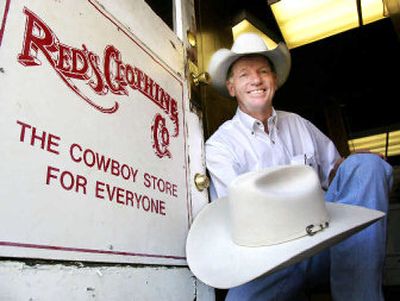Top-quality cowboy hats are harder to find

PENDLETON, Ore. — In some parts of the country, a man can be judged by the cut of his suit or his designer tie. Here, in a town known for its rodeo culture, men size each other up by the quality of their cowboy hats.
But good quality beaver and rabbit furs — which are used to make felt for the hats — are increasingly hard to find, making it more expensive to be a well-dressed cowboy. A top-grade hat can run as high as $6,000 today.
“It used to be you could pay $30 for a hat and it never leaked. Now you pay $300 and as soon as it clouds up, it leaks,” complained cowboy Bill McCoin, 55, a hired hand at a local cattle auction.
Hatmakers, he said, used the best quality beaver and rarely mixed the high-grade fur with lower-quality pelts, such as rabbit, creating hats that were feather-light yet durable.
“I bought my best hat for my wedding,” said McCoin. “It was a real good hat — it outlasted my marriage.”
In Garland, Texas, home of the 140-year-old Stetson Hat Co., the cost of the raw materials determines the bottom line, said Gary Rosenthal, Stetson’s product development manager. “And the raw material has gone up — a lot,” he said.
At the high end, for hats starting at $800, the felt is made entirely of beaver. But at the lower end for hats in the $250 range, the felt is often mixed with rabbit fur, mostly from Europe, where rabbits are raised for meat and fur traders bid on the skins after the animal has been butchered.
The drop of the dollar against the euro has made even the inferior fur expensive for American hatmakers.
“Two years ago, I used to be able to buy a kilo of rabbit fur for $2.20. Now, it’s $4.70. It just keeps going up and up. And we have no choice but to pass the cost down” to the hat industry, said Louis Pereira, owner of Newark, N.J.-based American Fur Felt, one of the last remaining fur cutting businesses in the United States.
The exchange rate is only part of the problem. Chinese fur manufacturers have recently embraced rabbit as well as beaver for garments, pushing the bidding higher. And butchers are killing rabbits younger — at six weeks, instead of two years. While the quality of the meat does not suffer, the fur does. “The older the rabbit, the stronger the fiber,” said Pereira.
A final factor is the growth in popularity of white rabbits, whose fur is not as thick or as durable as that of their colored cousins. “It’s a triple whammy,” said the fur cutter.
Compared to rabbit, wild beaver always have been expensive. But in recent years, the price of the already costly pelts has climbed even higher.
In December 2002, wild beaver pelts averaged $14.86. A year later, the price spiked to $17.96 and by December 2004, they averaged $20.02. The most recent figures for May of this year have beaver pelts selling for $21.20, according to Fur Harvesters Inc.
Even hatmakers that have the money to spend on the top-of-the-line pelts are finding that the best quality beaver is often ending up in the hands of foreign competitors.
“Russia and China have been gobbling them up,” said Dean Serratelli, co-owner of the Serratelli brand, the No. 2 cowboy hat company after Stetson. “The good raw materials are getting scarcer and scarcer.”
Add to that global warming.
The best quality fur comes from the underbelly of the beaver, which grows thick to protect the animal in the cold winter months. With winters around the world warmer than in the past, the pelts have not gotten as full as they did decades ago.
“It’s a fact that if it’s a warmer season, the fur is not as good quality,” said Jack Kellogg, a custom hat manufacturer in Wichita, Kan., whose hand-crafted hats under the Hatman Jack’s label are worn by a host of Western celebrities.
“One thing I’ve noticed with the bigger hat companies is to absorb some of the cost, they’re toying with their mixes. It’s very apparent,” he said, referring to the practice of adding rabbit and even synthetic fibers to strengthen the felt.
The quality — or the lack of it — is easy to detect, said Mike Wallis, owner of Red’s Hat Co. in Pendleton, a regular stop for style-conscious cowboys. “This one feels really good. This one feels exceptional,” he said running his hand first over a gray $350 cowboy hat, then on a cream-colored Resistol costing $550.
The felt of the more expensive hat is not only soft and fuzzy to the touch, the hat itself is also light — yet strong. “A really good hat is so light, it’s like putting a dollar bill on top of your head,” said Wallis. But it’s strong enough that “you can lean back in a four-wheeler and stare at the stars and not have it blow off,” he said.
Cowboy connoisseurs are quick to point out the difference between hats sold today and the hats their fathers wore.
Cattle rancher Robert Vestring, 85, of Burns, Kan., remembers walking into a hat shop in the 1970s and running his hand over a hat, soft as mink and supple. “I looked at this fine felt hat, real thin, the best money could buy and the owner said to me: ‘When the hats I have here are gone, there won’t be anymore.”’
Vestring bought eight of them — two for each of his three sons and two for himself. In 30 years, he says, he’s never found any that come close in quality and to this day, when he wears one of the fine hats, people — especially Texans — take note.